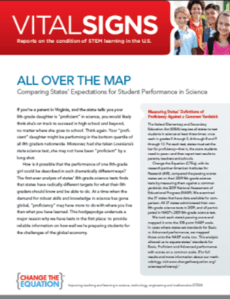 Parents, be aware: The “proficient” designation
that your child received on her state science test may not signify much. This
new report from Change the Equation (a STEM-advocacy outfit) and the American
Institutes for Research evaluates the proficiency cut scores of thirty-seven
states’ eighth-grade-science assessments, comparing their rigor to that of the
2009 National Assessment of Educational Progress. The upshot? Fifteen states
set their bars for proficiency below NAEP’s basic
designation. Virginia is the worst of the lot—setting its cut scores far below
the rest of the pack—and repaying itself with a 91 percent proficiency rate on
its state exam. Only four states (New Hampshire, Rhode Island, Massachusetts,
and Louisiana) expect their students to be at or above NAEP’s "proficient"
threshold. (Feeling a bit of déjà vu? This report is a lot like Fordham’s own Proficiency
Illusion blockbuster from 2007, in which we drew similar conclusions
about reading and math.) A word on the forthcoming common science standards: This
work is necessary—and hugely important. But, as we are reminded time and again,
it is not sufficient. A failure to link quality standards to rigorous assessments
with balanced cut scores is akin to swiping the legs of any common science-standards
initiative, just as it’s learning to walk.
Parents, be aware: The “proficient” designation
that your child received on her state science test may not signify much. This
new report from Change the Equation (a STEM-advocacy outfit) and the American
Institutes for Research evaluates the proficiency cut scores of thirty-seven
states’ eighth-grade-science assessments, comparing their rigor to that of the
2009 National Assessment of Educational Progress. The upshot? Fifteen states
set their bars for proficiency below NAEP’s basic
designation. Virginia is the worst of the lot—setting its cut scores far below
the rest of the pack—and repaying itself with a 91 percent proficiency rate on
its state exam. Only four states (New Hampshire, Rhode Island, Massachusetts,
and Louisiana) expect their students to be at or above NAEP’s "proficient"
threshold. (Feeling a bit of déjà vu? This report is a lot like Fordham’s own Proficiency
Illusion blockbuster from 2007, in which we drew similar conclusions
about reading and math.) A word on the forthcoming common science standards: This
work is necessary—and hugely important. But, as we are reminded time and again,
it is not sufficient. A failure to link quality standards to rigorous assessments
with balanced cut scores is akin to swiping the legs of any common science-standards
initiative, just as it’s learning to walk.
| Click to listen to commentary on this science "proficiency illusion" from the Education Gadfly Show podcast. |
Change the Equation and the American Institutes for Research, All Over the Map: Comparing States’ Expectations for Student Performance in Science (Washington, D.C.: Change the Equation and the American Institutes for Research, December 2011).
